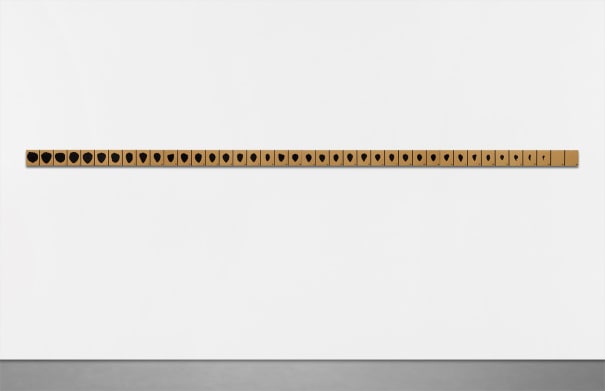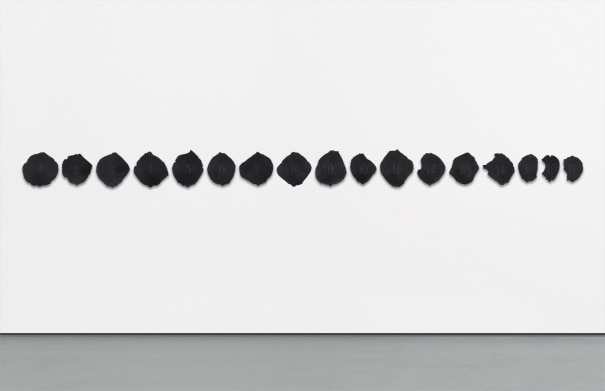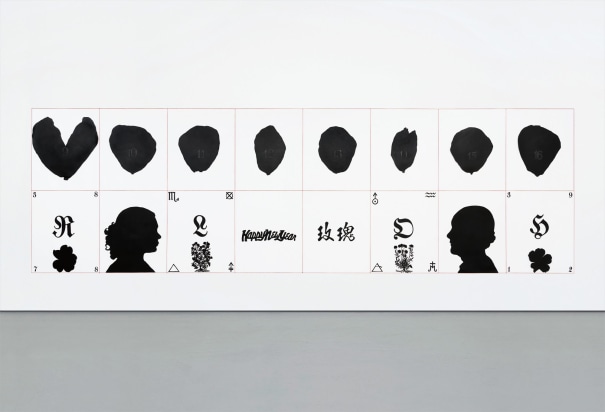Roberto Obregón Ene Eme y Ene De 1994 cut rubber and long-staple wool 79 1/8 x 262 5/8 in. (201 x 667.1 cm)
Provenance Acquired directly from the artist Private Collection, Miami Exhibited Caracas, Fundación Sala Mendoza, Roberto Obregón - el elocuente silencio de las formas, May 5, 2013 Literature A. Jiménez, Roberto Obregón - El elocuente silencio de las formas, 2012 n.p. (illustrated) A. Jiménez, Roberto Obregón - En Tres Tiempos, Caracas, 2013, p. 212-213 (illustrated) Catalogue Essay The present lot, Ene Eme, y Ene De, 1994, is a monumentally important piece within Roberto Obregón’s pivotal series Las Niágaras. This intimate series evokes aspects of Obregón’s personal life through the portraits of people close to him, who impacted his life in one way or another. The present lot is the culmination of a primary leit motif throughout his body of work: the rose and the concept of cyclical time, which encompass the unique and complex symbolism that defines his practice. It is this highly personal approach and subject matter that has placed Obregón at the forefront of the Latin American contemporary art scene. The motif of roses first impacted Obregón at the early age of nine, when he visited his aunt who had a garden with a very prominent rose bush. These exquisite roses caused an indelible impression on him, exacerbated by the fact that he was forbidden from touching them. He would go on to obsessively collect images of roses that he gleaned from magazines and postcards. His earliest work focused on documenting his physical, bodily decay over time, which would become his obsession. He expressed this notion of cyclical time through his work, for example in Crónicas de una rosa (no.1) [Chronicles of a rose (no.1)], 1974. In this case, he photographed the decay of a rose sequentially, in a style reminiscent of Eadweard Muybridge This method of documentation has interested many artists throughout history, including Monet who would document the chromatic transformations of environments over time. Obregón later stopped using photography as a medium, and started physically dissecting the flower in numerous ways, one of them being through the use of cut rubber, as he believed the use of rose imagery “gave weight to my work”. Ariel Jiménez aptly describes the symbolism of the rose where “…a flower is not only a flower that has petal after petal in a circular structure, rather, it also superimposes symbol over symbol: of youth, of freshness, of love, of loving commitment. It can allude to mourning, and from what I see, it is also a very old organism, prior not only to culture, but to humanity itself.” In this sense, Obregón’s petal dissections can be read as the intent to gradually accumulate (in consecutive layers) everything that a rose could possibly mean for humanity. The dissected flowers rendered in his creations highlight the bond that exists between the body and nature, as cycles of time and decay affect both the body and the flower. This visual comparison can also be found within the work of Félix González-Torres. In the series Las Niágaras, Obregón brought another autobiographical dimension into his body of work. The title of the series originated from Marilyn Monroe’s movie Niagara. The title of the movie was translated in Spanish as Torrentes Pasionales (Torrents of Passion.) Obregón believed that a person’s biography is like a torrent of passion and, coincidentally, the name of Marilyn Monroe’s character in the movie was Rose. Each work in the Niagara series is like an encounter or an imaginary conversation between two persons—usually a female and a male character— who Obregón knew or who influenced him. Depending on the characters, the frame or border that surrounds them will sometimes change color according to gender, red for females and blue for males. The title of the present lot is the initials spelled out “nm and nd,” alluding to Norma Marilyn and Marcel Duchamp Throughout this series Obregón attempted to write Marilyn’s name in different languages, ranging from Chinese to Russian and French. In the case of Ene Eme y Ene
Roberto Obregón Ene Eme y Ene De 1994 cut rubber and long-staple wool 79 1/8 x 262 5/8 in. (201 x 667.1 cm)
Provenance Acquired directly from the artist Private Collection, Miami Exhibited Caracas, Fundación Sala Mendoza, Roberto Obregón - el elocuente silencio de las formas, May 5, 2013 Literature A. Jiménez, Roberto Obregón - El elocuente silencio de las formas, 2012 n.p. (illustrated) A. Jiménez, Roberto Obregón - En Tres Tiempos, Caracas, 2013, p. 212-213 (illustrated) Catalogue Essay The present lot, Ene Eme, y Ene De, 1994, is a monumentally important piece within Roberto Obregón’s pivotal series Las Niágaras. This intimate series evokes aspects of Obregón’s personal life through the portraits of people close to him, who impacted his life in one way or another. The present lot is the culmination of a primary leit motif throughout his body of work: the rose and the concept of cyclical time, which encompass the unique and complex symbolism that defines his practice. It is this highly personal approach and subject matter that has placed Obregón at the forefront of the Latin American contemporary art scene. The motif of roses first impacted Obregón at the early age of nine, when he visited his aunt who had a garden with a very prominent rose bush. These exquisite roses caused an indelible impression on him, exacerbated by the fact that he was forbidden from touching them. He would go on to obsessively collect images of roses that he gleaned from magazines and postcards. His earliest work focused on documenting his physical, bodily decay over time, which would become his obsession. He expressed this notion of cyclical time through his work, for example in Crónicas de una rosa (no.1) [Chronicles of a rose (no.1)], 1974. In this case, he photographed the decay of a rose sequentially, in a style reminiscent of Eadweard Muybridge This method of documentation has interested many artists throughout history, including Monet who would document the chromatic transformations of environments over time. Obregón later stopped using photography as a medium, and started physically dissecting the flower in numerous ways, one of them being through the use of cut rubber, as he believed the use of rose imagery “gave weight to my work”. Ariel Jiménez aptly describes the symbolism of the rose where “…a flower is not only a flower that has petal after petal in a circular structure, rather, it also superimposes symbol over symbol: of youth, of freshness, of love, of loving commitment. It can allude to mourning, and from what I see, it is also a very old organism, prior not only to culture, but to humanity itself.” In this sense, Obregón’s petal dissections can be read as the intent to gradually accumulate (in consecutive layers) everything that a rose could possibly mean for humanity. The dissected flowers rendered in his creations highlight the bond that exists between the body and nature, as cycles of time and decay affect both the body and the flower. This visual comparison can also be found within the work of Félix González-Torres. In the series Las Niágaras, Obregón brought another autobiographical dimension into his body of work. The title of the series originated from Marilyn Monroe’s movie Niagara. The title of the movie was translated in Spanish as Torrentes Pasionales (Torrents of Passion.) Obregón believed that a person’s biography is like a torrent of passion and, coincidentally, the name of Marilyn Monroe’s character in the movie was Rose. Each work in the Niagara series is like an encounter or an imaginary conversation between two persons—usually a female and a male character— who Obregón knew or who influenced him. Depending on the characters, the frame or border that surrounds them will sometimes change color according to gender, red for females and blue for males. The title of the present lot is the initials spelled out “nm and nd,” alluding to Norma Marilyn and Marcel Duchamp Throughout this series Obregón attempted to write Marilyn’s name in different languages, ranging from Chinese to Russian and French. In the case of Ene Eme y Ene



.jpg)
.jpg)

.jpg)
.jpg)
.jpg)
.jpg)
.jpg)


Try LotSearch and its premium features for 7 days - without any costs!
Be notified automatically about new items in upcoming auctions.
Create an alert